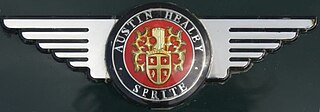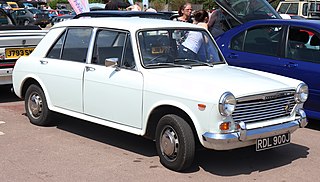
The Mini is a two-door compact city car that was produced by the British Motor Corporation (BMC) and its successors from 1959 until 2000. The original Mini is considered an icon of 1960s British popular culture. Its space-saving transverse engine and front-wheel drive layout – allowing 80% of the area of the car's floorpan to be used for passengers and luggage – influenced a generation of car makers. In 1999, the Mini was voted the second-most influential car of the 20th century, behind the Ford Model T, and ahead of the Citroën DS and Volkswagen Beetle. The front-wheel-drive, transverse-engine layout of the Mini was copied for other "supermini" designs including the Honda N360 (1967), Nissan Cherry (1970), and Fiat 127 (1971). The layout was also adapted for larger subcompact designs.

A hatchback is a car body configuration with a rear door that swings upward to provide access to a cargo area. Hatchbacks may feature fold-down second row seating, where the interior can be reconfigured to prioritize passenger or cargo volume. Hatchbacks may feature two- or three-box design.

The Morris Marina is a front-engined, rear-wheel-drive small family car that was manufactured by the Austin-Morris division of British Leyland from 1971 until 1980. It served to replace the Morris Minor in the Morris product line, which had first been built in 1948. The Marina was also sold in some markets as the Austin Marina, the Leyland Marina and the Morris 1700.

The Austin Allegro is a small family car that was manufactured by the Austin-Morris division of British Leyland from 1973 until 1982. The same vehicle was built in Italy by Innocenti between 1974 and 1975 and sold as the Innocenti Regent. The Allegro was designed as a replacement for the Austin 1100 and 1300 models. In total, 642,350 Austin Allegros were produced during its ten-year production life, most of which were sold on the home market, less than a third of 2.1 million 1100s and 1300s sold in the previous 11 years.

British Leyland was an automotive engineering and manufacturing conglomerate formed in the United Kingdom in 1968 as British Leyland Motor Corporation Ltd (BLMC), following the merger of Leyland Motors and British Motor Holdings. It was partly nationalised in 1975, when the UK government created a holding company called British Leyland, later renamed BL in 1978. It incorporated much of the British-owned motor vehicle industry, which in 1968 had a 40 percent share of the UK car market, with its history going back to 1895. According to Companies House, the holding company “British Leyland Ltd” is still in existence, renamed “Rover Group Holdings ” and latterly “ BMW UK Holdings “.

The Austin-Healey Sprite is a small open sports car produced in the United Kingdom from 1958 until 1971. The Sprite was announced to the press in Monte Carlo by the British Motor Corporation on 20 May 1958, two days after that year's Monaco Grand Prix. It was intended to be a low-cost model that "a chap could keep in his bike shed", yet be the successor to the sporting versions of the pre-war Austin Seven. The Sprite was designed by the Donald Healey Motor Company, with production being undertaken at the MG factory at Abingdon. It first went on sale at a price of £669, using a tuned version of the Austin A-Series engine and as many other components from existing cars as possible to keep costs down.

The Metro is a supermini car, later a city car that was produced by British Leyland (BL) and, later, the Rover Group from 1980 to 1998. It was launched in 1980 as the Austin miniMetro. It was intended to complement and eventually replace the Mini, and was developed under the codename LC8. The Metro was named by What Car? as Car of The Year in 1983 as an MG, and again as a Rover in 1991.

The Talbot Horizon is a compact hatchback that was designed by Chrysler Europe and was produced from 1978 to 1987 under the Chrysler, and Talbot nameplates. The successor of both the Simca 1100 and Hillman Avenger, the Horizon adopted a front-wheel drive, transverse-engine layout.

A sunroof is a movable panel that opens to uncover a window in an automobile roof, allowing light and fresh air to enter the passenger compartment. Sunroofs can be manually operated or motor driven, and are available in many shapes, sizes and styles. While the term sunroof is now used generically to describe any glass panel in the roof, the term "moonroof" was historically used to describe stationary glass panes rigidly mounted in the roof panel over the passenger compartment. A moonroof has a glass panel that is transparent and usually tinted. Previous terms include Sunshine Roof, Sliding Head and Sliding Roof.

The Austin Maxi is a medium-sized, 5-door hatchback family car that was produced by Austin and later British Leyland between 1969 and 1981. It was the first British five-door hatchback.

The Triumph 1300 is a medium/small 4-door saloon car that was made between 1965 and 1970 by Standard Triumph in Coventry, England, under the control of Leyland Motors. It was introduced at the London Motor Show in October 1965 and intended as a replacement for the popular Triumph Herald. Its body was designed by Michelotti in a style similar to the larger Triumph 2000. It was replaced by the Triumph 1500, though it was also re-engineered in the early 1970s to provide the basis for the Toledo and Dolomite ranges.

The BMC ADO16 is a range of small family cars built by the British Motor Corporation (BMC) and, later, British Leyland. Launched in 1962, it was Britain's best-selling car from 1963 to 1966 and from 1968 to 1971. The ADO16 was marketed under various make and model names; however, the Austin 1100 and Morris 1100 were the most prolific of all the ADO16 variants.

Trojan was a British automobile manufacturer producing light cars between 1914 and 1965, and light commercial vehicles for a short time.

The CitiCar is an electric car produced from 1974 to 1977 by Sebring, Florida–based Sebring-Vanguard, Inc. After being bought out by Commuter Vehicles, Inc, Sebring-Vanguard produced the similar Comuta-Car and Comuta-Van from 1979 to 1982. Similarities to its exterior design can be spotted in the Danish Kewet and the later Norwegian Buddy electric car. Accounting for all CitiCar variants, a total of 4,444 units were produced up to 1979, the most since 1945 for an electric car assembled in North America until surpassed by the Tesla Model S.
Hydrolastic is a type of space-efficient automotive suspension system used in many cars produced by British Motor Corporation (BMC) and its successor companies.

The Dodge Charger is a full-size four-door sedan, introduced first at the 2005 North American International Auto Show and built by American automobile manufacturer Stellantis North America, a subsidiary of Stellantis. It is available in rear-wheel drive or all-wheel drive drivetrains. The Charger was developed to continue the Dodge Charger line with its muscle car heritage, and replaced the Dodge Intrepid as Dodge's full-size sedan. The seventh-generation Charger debuted for the 2011 model year.

The GTM Coupé is a Mini based kit car dating back to 1967. GTM is an initialism for "Grand Touring Mini". The car was first shown at the 1967 Racing Car Show and soon afterwards went into production by the Cox brothers from their garage in Hazel Grove, Stockport as the Cox GTM. In 1969 the rights to the design and manufacturing were bought by Howard Heerey and the Cox part of the name was dropped. His father's company Midland Garage took over manufacture of the GTM. In April 1980 ownership changed again to GTM Engineering, who upgraded and continued to manufacture the Coupé until 1995.

The Mini Scamp is a Mini based kit car manufactured by Andrew MacLean and the Scamp Motor Company in West Sussex. The Mk1 Mini Scamp was built in 1969. Shortly after, BMC Mini Moke production stopped in Longbridge.
There have been a number of Mini concept cars, produced to show future ideas and forthcoming models at international motorshows.



















